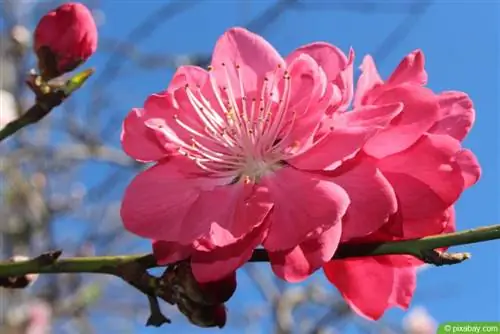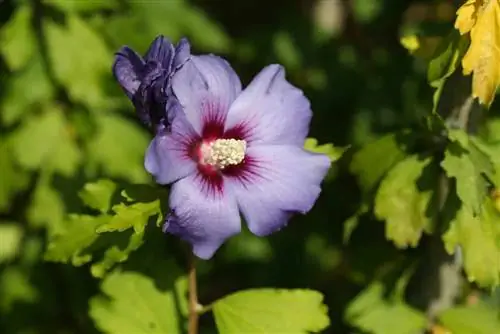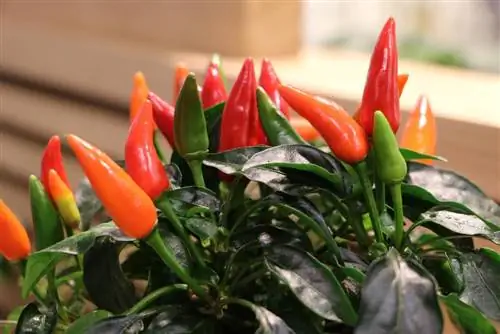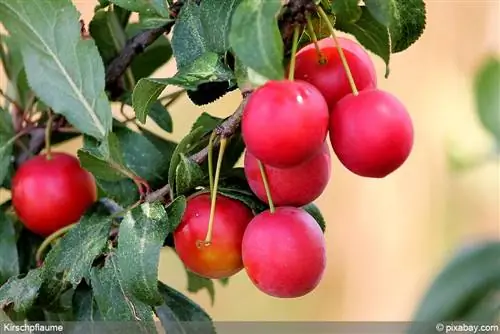- Author admin [email protected].
- Public 2023-12-17 03:39.
- Last modified 2025-06-01 06:48.
The ornamental peach is a real ornament in the garden in spring with its flowers and can be an eye-catcher for years as one of the first flowering plants. However, the tree is only that if it is properly cared for. The comprehensive instructions show what is important and what needs to be taken into account.
Location
The ornamental peach requires a sunny to partially shaded and protected location. The plant should be kept warm and not exposed to cold winds or extreme rainfall. This is especially true for the culture of the tree in the pot.
Partial shade or slightly covered areas, for example on the balcony or terrace, are also suitable locations.
Substrate
Ornamental peaches are undemanding when it comes to the substrate. Normal garden soil is completely sufficient. Pot soil or a mixture of garden and plant soil are also suitable. In addition to a moderate nutrient content, it is important that the soil is permeable and loose. The plants cannot tolerate waterlogging or compacting substrate.
Plants
The ornamental peach is best planted outdoors in early autumn or late spring. Since the frost hardiness is low, it should only be planted outdoors in areas with mild winters. At altitudes and in harsher winters, growing in a container is the better choice.
Culture in a bucket

When cultivating ornamental peaches in the pot, you should pay attention to a few points. These are:
Drainage
So that the roots do not stand in water, a drainage layer should be placed in the bucket. Coarse gravel, stones or shards of pottery are well suited for this. They are simply placed as the bottom layer in the bottom planter to create a distance between water and roots.
Stability
The bucket should be stable and stable. To do this, it must be of sufficient size and of appropriate weight. The ornamental peach can reach a height of up to three meters, so a tip-proof base is crucial. A drainage layer made of stones can help make the bucket heavier and at the same time allow the water to drain away better.
Care
Care for pot cultivation is slightly more effortless than outdoors because there is less substrate available. It is necessary to water and fertilize more frequently and also to ensure appropriate winter protection.
Protection
In winter, the peach tree in the pot can quickly freeze to death because the root ball is surrounded by less substrate and therefore receives less protection from the earth.
Pouring
The plant is also easy to care for when watering the ornamental peach. The substrate should never dry out completely, but should not be wet either. Watering is therefore carried out as needed, ideally with soft, low-lime water. Suitable are:
- collected rainwater
- Pond water or aquarium water
- stale tap water
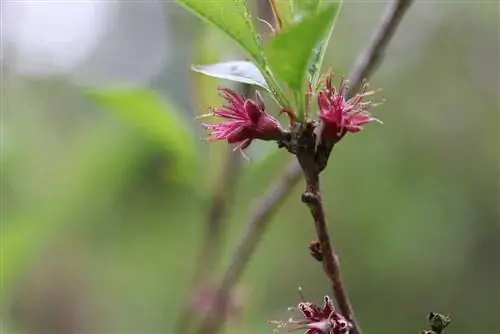
The advantage of pond water and aquarium water is that it also contains some organic nutrients. So it can also be used for fertilization. In the case of rainwater and stale tap water, the sediment should not be poured. Because that's where the lime is.
Tip:
The so-called thumb test can show whether the plant needs to be watered. To do this, press a finger into the substrate - if it remains dry, the tree should be watered. However, if the substrate sticks to your finger, watering is not necessary.
Fertilize
The supply of nutrients for the ornamental peach is only important and necessary during the growth phase. The exact period depends on the varieties. On average this is April to July. As a rule of thumb, fertilization can begin with the first shoots in spring. The additional nutrient supply must be limited by August at the latest because the plant can potentially absorb fewer nutrients and fertilizer prevents it from going into winter dormancy and can cause chemical burns on the roots.
A complete fertilizer can be used. Well-rotted compost is also suitable. In any case, water should be given after fertilization. This means that the nutrients are distributed better and damage to the roots can be effectively prevented.
Flowering time
The flowering time fundamentally depends on two factors. On the one hand, the climatic conditions. Mild winters and an overall warm climate produce an earlier flowering period. It can start as early as March or as late as May. On the other hand, the varieties play a role. Melred blooms from around the end of March. Spring glow, on the other hand, starts in February - if the conditions are right.
Edible or poisonous?
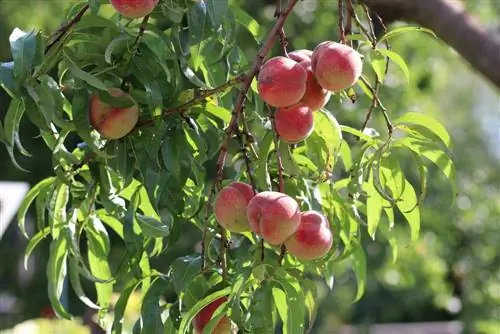
The fruits of ornamental peach trees are entirely edible and not poisonous. Even if the flowers of Melred and Co. are often the main reason for purchasing them, the fruits can be eaten fresh or processed. They are not poisonous to humans, but again depending on the variety they can be very juicy and sweet. Drying, preserving or pickling the fruit is possible. However, the core should be removed in advance. The ideal harvest time begins around the end of July.
Cutting
The trimming of the ornamental peach is extremely simple and possible even for people with no experience in plant care and without a green thumb. Only a few factors need to be taken into account when making the waste:
Time
The cutting takes place either in early spring or late autumn. Experience has shown that spring is the better choice as damaged or dead parts can be removed. On the one hand, this allows the shape of the tree crown to be better preserved and, on the other hand, the best conditions can be created for the tree. It is important that the peach tree has as few leaves as possible when it is cut. You should also wait for a frost-free day with low humidity. The cut surfaces can then dry out very quickly and the risk of invading germs and parasites can be kept low.
Cleanliness
The cutting tool should be kept clean to prevent infection of the plant. For this reason, disinfection should be carried out before and after cutting. This removes pathogens and other contaminants that could cause infections.
Procedure
The most important thing is that there is regular waste. This means that the interference with growth is minimal and the interfaces are as small as possible. All shoots that grow inwards or cross each other are removed or shortened. In addition, dead or otherwise damaged shoots should be removed after flowering and harvesting. This prevents the cutting from becoming a major procedure. This conserves the tree's energy reserves. In addition, the effort is lower and the time required is correspondingly low.
Wintering
Overwintering the ornamental peach is easy, but requires appropriate protection. There are two options for this.
Wintering in the house:
1. The plant is moved indoors in the fall before the first frost.
2. The location should be bright and frost-free.
3. The soil is prevented from drying out, but fertilization is stopped. 4. Shedding leaves is completely normal.
Overwintering outdoors with pot culture:
1. Insulation from below, for example with Styrofoam, protects roots.
2. Insulation from the outside protects the root ball from the sides.
3. A top cover prevents excessive liquid from entering. For example, fleece, jute, straw and brushwood are ideal for this.
When overwintering outdoors, the root disc should be covered with brushwood to provide separate protection. In addition, care must be taken to ensure that there is sufficient but not too much liquid in the substrate to prevent damage to the roots.

